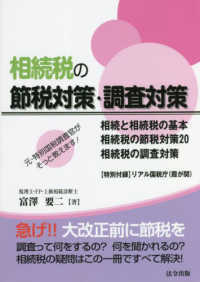Full Description
This book is about the most precious "piece of paper" we know, about banknotes and about the industry that makes them. We have banknotes in our hands daily. Modern life would be unthinkable without them, yet we know nothing about how they are made or who makes them. This secrecy is regularly explained as "legitimate" special security for a very special product. But it also has to do with the unusual, highly politicized structure of the market in which central banks, as well as state and private banknote printers, operate. The armaments industry immediately comes to mind. This obsession with secrecy, however, seems out of place in the era of the internet. After all, banknote printing involves the massive use -- and often waste -- of taxpayers' money. This is the first book offering an in--depth view of the banknote industry and its modus operandi. The only known former attempt to reveal this story was by an American author (Terry Bloom: The Brotherhood of Money. The Secret World of Banknote Printers, BNR Press, Port Clinton, Ohio 1983). The edition of that book was bought up -- straight from the printing presses -- by two prominent Swiss representatives of the industry because the public was not supposed to get an inside view of the business. Today Bloom's book is hard to find even at dealers specialized in old books. An American dealer in 2002 had one copy on offer for 150 Dollars. MONEYMAKERS has been researched over a five--year period in Europe, the USA and Latin America. The book is based exclusively on personal interviews and confidential material normally not accessible to outsiders. There were attempts to stop this research project. Many witnesses interviewed spoke under condition of strict confidentiality for fear of reprisals by their employers. As a rule therefore, the author refrained from verbatim quotes and, as far as possible, tried to confirm every piece of information by two independent sources.
Contents
The introductory chapter offers an outline of the history of money with the emphasis on paper money. The first topic group ("Moneymakers I", 3 chapters) initially explains the peculiarities of the banknote business (Chapter 2) as a market limited to selected members and muted competition. It is the story (Chapter 3) of Gualtiero Giori, a machinery engineer, and his "System Giori". A couple of hitherto unpublished episodes show how Giori, with the help of the German machinery constructing firm of Koenig & Bauer, convinced central banks to building expensive printing works which were not always needed. Next comes the story (Chapter 4.) of Albert Amon, Giori-s close friend and producer of special inks for banknote printing. Amon's company, Sicpa, enjoys a de facto monopoly of the world market for these exclusive inks and can ask almost any price. The second topic group ("Moneymakers II", comprising 3 chapters) describes the varied fate of today's three leading private banknote printers - from Britain, France and Germany. The private British banknote printer and papermaker De La Rue plc. (Chapter 5) ruled the world market for banknotes. However a sequence of management mistakes committed by rapidly changing CEO-s has reduced this once proud company to a shadow of its former self. Not even efforts to strike secret deals with markets and/or prices could avert that fate. Quite different is the story (Chapter 6) of the private German banknote printer Giesecke & Devrient. The latter was almost completely destroyed during WW II; but under its charismatic and aggressive owner, Siegfried Otto, it became the only full vertically integrated, high security company in the world, covering everything from paper to printing, to banknote inspection systems and shredders for used banknotes. Market entry into the profitable banknote business may be difficult, yet Chapter 7 shows that it can be done with entrepreneurial courage - plus some help from important political friends. Thus private French printer Francois Charles Overthur Fiduciaire succeeded even though he was a latecomer. The third topic ("Money Destroyers", comprising 2 chapters) deals with the "losers". Even in a highly lucrative business, unreasonable profit expectations and lack of judgment can lead to doom and failure. Chapter 8 exposes the developments around the privatization of the Bundesdruckerei in Berlin where complete lack of strategy, in combination with greed, led to the loss of thousands of jobs and near ruin. Likewise (Chapter 9) the owner of Ciccone Calcografica, a printing plant in Argentina, dreamt of banknote printing as a source of high and continuous profits. The firm's highly leveraged expansion into high security printing drove it into the arms of a gang of international Mafiosi on whose orders they printed "genuine fake banknotes" for Zaire and Bahrain. The fourth and final topic ("Money Worries", 3 chapters) uses the concrete example of the euro and describes not only the politically, but also technically painful paths toward a true common currency. The story is told (Chapter 10) of how the involvement of too many paper suppliers and printing works - public as well as private - pushed up the production costs at the same time as lowering the quality of the new euro-notes. Chapter 11 deals with the fact that for the first time in modern history there are two block-currencies available for trading and for hoarding purposes, the dollar and the euro. Both today are massively threatened by an ultra-modern reproduction technology, and both have a rather different approach to the question of banknote security. Lastly in Chapter 12, the introduction of the Common European Currency was supposed to strengthen competition and market forces in general. Unfortunately the euro in one particular instance, that is in banknote printing, opens the back door to disintegration of private industry and even to its nationalization.







